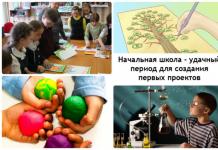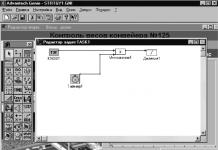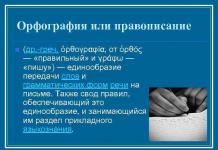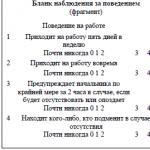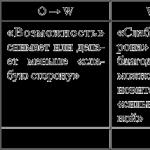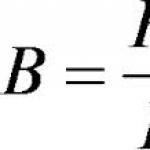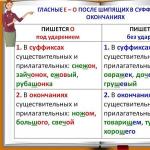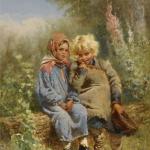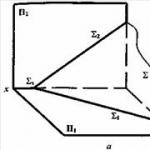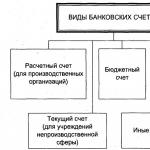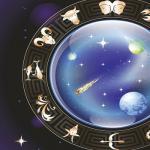Glass decanter using paper art technique.
You can create real magic with your own hands thanks to Tatyana Sorokina’s signature paper art decoration technique.
Well, isn’t it magic - using table napkins, PVA glue and gouache to transform glass, plastic and even cardboard into antique copper, noble silver or antique bronze?!
I came across a very interesting idea for partially decorating the surface of a product using paper art technique from Natashkin from the Country of Masters. Natashkin's daughter Alevtina is the author of exquisite wine glasses framed using the paper art technique.
I've been wanting to do something like this for a long time. Therefore, today I present my version of a craft, partially decorated using Tatyana Sorokina’s original paper art technique:
Master class on decorating a bottle using paper art technique
This is a glass bottle in the shape of a decanter:

And I'm going to make a "bronze" frame for this decanter.
To decorate a bottle using paper art technique I will need:
- table napkin
- PVA glue
- scissors
- bronze acrylic paint
- piece of foam rubber
- bamboo skewer
- millet cereal
- curly pasta in the shape of stars
- gouache (red, black, green)
- brushes (with synthetic bristles - for PVA glue, with natural bristles - for varnish)
- glossy acrylic varnish
- wet sanitary napkins
Important note: high-quality PVA glue is required for this work. I use the same one PVA glue and acrylic varnish , as for works using the decoupage technique.
1. Preparing the bottle surface for paper art
Before I start decorating using the paper art technique, I degrease the surface of the bottle and remove any remaining glue from the labels using wet sanitary napkins.
Since only part of the surface of the bottle will be decorated with paper art, I will not cover the decanter with a napkin, as is usually done. Otherwise, glued napkins and other decor will be visible from the inside of the bottle through the glass.
I cover with PVA glue the part of the surface of the bottle where it is supposed to make a “bronze” frame using the paper art technique.

I apply several layers of PVA with intermediate drying to prepare the base for laying out paper art patterns. I remove excess glue that spreads beyond the boundaries of the future “bronze” frame of the bottle with a damp cloth.
After the PVA glue has completely dried, I cover the primed part of the bottle with bronze acrylic paint using a sponge made from a piece of foam rubber.

Thus, from the inside, the frame of the decanter will have a “bronze” appearance.
2. Patterns using paper art technique
To create a pattern using the paper art technique, I use double flagella from napkins, millet cereals and curly star pasta.
To make a double flagellum from a napkin, first I make a long single flagellum.
To make a long single flagellum, in the process of twisting, I connect several napkin strips, overlapping the ends of the strips one on top of the other.

I additionally seal the junction of the napkin strips in the flagellum with my fingers so that the paper art flagellum has the same thickness along its entire length.
Having rolled up a single tourniquet of four strips of napkin, I twist its ends in opposite directions, while keeping the tourniquet taut. This procedure is similar to the process of making twisted cord.
After the napkin tourniquet is rolled up as far as it will go, I hold the tourniquet in the middle with one hand, and with the other hand I connect its ends together, and the tourniquet is twisted.

I coat the borders of the “bronze” frame for a bottle with PVA glue using the paper art technique

and glue a double flagellum folded from a napkin before it has time to dry.
To create paper art patterns, napkin flagella must be wet. If the finished tissue rope has already dried out, it must be slightly moistened with water so that the tissue rope becomes plastic again

To ensure that the flagellum sticks tightly to the surface of the bottle, you can additionally press it with a brush dipped in PVA.
All kinds of sewing accessories (locks, buttons, rivets), as well as cereals, are also suitable for decorating crafts.
Therefore, as a complement to the napkin flagella, I lay out patterns of millet cereals and curly star pasta. To do this, I first draw pattern elements on the surface of the bottle with PVA glue, and then lay out the millet and pasta stars using a bamboo skewer.

I also use a napkin cord to decorate the lower part of the bottle frame.
In addition, I lay out identical patterns of flagella and cereals on each side of the decanter.


It is very important to fix the paper art patterns well. I cover the decor glued to the surface of the bottle using paper art technique with PVA glue. I apply several thin layers of glue so as not to fill the relief elements of the pattern. I dry each layer of PVA.

If pasta sticks to the primed surface of the bottle immediately and almost tightly, then millet groats lag behind quite easily. That is why I pay the most attention to areas with pasted millet. In these places I apply 4-5 layers of PVA.
And now the paper art patterns are laid out and securely fixed. Before proceeding to the next stage of work, I dry the bottle for 12 hours.
3. Painting a bottle using paper art technique
In order for the finished frame for a glass bottle to look like bronze, the surface with paper art patterns must be painted.
I mix red, green and black gouache. At the same time, I am very reminiscent of the cartoon character Vrednyuga, who mixed bright multi-colored paints to make mud. But in the end I get a mixture that, in my opinion, is very similar in color to antique bronze that has darkened over time.
I add glossy acrylic varnish to the gouache in a 1:1 ratio. The composition, as usual, turns out to be too thick, so I dilute it with a small amount of water to the consistency of acrylic paint.
I apply the resulting paint to the surface of the bottle frame using a piece of foam rubber.

I cover the frame with several layers of paint with intermediate drying. I pay special attention to places with a relief pattern. It is very important that all decorative elements are well painted.
4. Bottle tinting using paper art technique
When the paint has dried, I tint the surface of the bottle frame with bronze acrylic paint.
To do this, I put a little paint on a foam sponge, make several impressions on paper with the sponge, and then, without pressing, wipe the surface of the bottle with patterns using the paper art technique with the sponge.

5. Fixation of work using paper art technique
I fix the paper art work with glossy acrylic varnish. I cover the bottle with two layers of varnish. I dry each layer of acrylic varnish for 3 hours.

After the last layer of varnish has dried, I use a damp cloth to remove excess paint, glue and varnish along the edges of the “bronze” frame of the bottle. Now you can admire the finished craft using the paper art technique.
These are the details of the paper art patterns on the surface of the decanter and on the top of the stopper:

And this is the bottle itself, decorated using paper art technique:

In my opinion, the combination of glass and “antique bronze” looks very noble. Is not it?
Natalia Popova
Target master class:
Improvement of pedagogical master participants' skills– class in the process of active communication to master a new paper art techniques.
Tasks master class:
Introduce new paper art technology, which reveals the creative potential of children through direct and commented demonstration of a sequence of actions with the active participation of teachers;
Develop interest in new things technologies;
Arouse the desire of teachers to use paper technique– art in working with preschoolers.
Equipment and materials: tables and chairs according to the number of participants, multimedia presentation, paper napkins, scissors, knitting needle, towel, water container, PVA glue, blank with a pattern.
Event plan master class:
1. Introductory part.
2. Main part.
3. Reflection.
Move master class
1. Introductory part
In the conditions of the Federal State Educational Standard of preschool education, the development of creative abilities in children acquires special significance. Modern society needs creative, independent, active individuals, with pronounced individual qualities, who can think creatively. The development of children's creative abilities is the most important task of modern education. They help to simulate the creative potential of children, and therefore develop their creative abilities. non-traditional art techniques.
Today I want to introduce you to unconventional technology« Pape art» (translated from English means « paper art» ). Originally this The technique was called Napkin plastic». Technique« Paper art» was invented in 2006 by Tatyana Sorokina, artist, designer and head of the studio of literary and visual creativity "Watercolor" Nikolaev, Ukraine.
What is it « paper art» ?
This decorating technique with paper napkins, or rather, making a drawing with a thread from napkins.
With this techniques you can decorate bottles, boxes, gift packaging, flower pots, wall plates.
« Paper art» goes well with mosaic, decorative stones, stucco made of plastic or salt dough. This technique, imitating other, more expensive image techniques, for example, such as carving, embossing, weaving.
The technique is easy to perform, since it was originally invented for children in the studio, and works on cheap and waste material. Therefore, it can be successfully used in working with preschoolers, starting from an older age, developing them and involving them in the world paper.
File "/upload/blogs/detsad-2071841466773911.jpg" not found!
Working with regular canteens napkins It just fascinates children.




This is a very affordable, colorful material, easy to work with. Napkins can be cut, they can be torn, laid in layers, selected by color, painted, glued, etc.


During classes decoratively-applied arts instill moral and strong-willed spirit in children quality: the need to bring the job started to completion, to study with concentration and purpose.


Also creating works in technology« paper art» allows:
Teach simple sensory analysis;
Develop fine motor skills;
Ensure correct perception of work processes;
Overcome uncertainty and fear of unfamiliar things;
Develop creative activity.
Foster a caring attitude towards objects and toys as a result labor: your own and adults;
Starting with simple jobs,


we can gradually obtain from children masterpieces worthy of admiration.


During classes technology« Pape art» the baby's hand turns into a skilled hand masters, who can not only create miracles from paper, but also ready for school.


Main part:
Dear Colleagues! Today we will plunge into magic paper art techniques. And it will help us with this - gold fish.
For work we need: paper napkins, scissors, knitting needle or skewer for styling napkin flagella, towel, water container, PVA glue, blank with a pattern.

We fold napkin halve and cut into strips 1.5 centimeters wide


We disassemble the strips, each should have two layers left. Holding the strip by one end, lower it into the water and immediately remove it. Don't hold it for long, it will get wet.


Place on a towel to absorb excess moisture, then twist the threads or flagella.


When the threads are ready, we move on to the design of the drawing.


Lubricate the outline of the pattern with PVA glue, then lay it out with flagella, straightening it with your fingers or a knitting needle.


We cut off the excess with scissors or tear it off.

When the outline is ready, in order to save time, we decorate the inside not with flagella, but "reaper" another way to paper art.
We cut napkin into small pieces, fold the piece in half, moisten it with water and apply it to the desired place, already greased with glue. We assemble with a knitting needle (click) napkin. Lubricate a piece of cardboard with glue along with the glued piece, apply the next overlap and squeeze again and fill out the form.




Try to keep the header pattern in one direction.

I decided to show you three ways at one work and the next one is grain (balloons). We will decorate the eye for them. We tear off a small piece from the flagellum and roll it into a ball. Glue.


Our the fish is ready.
And he will fulfill fish, my three wishes...
I will become happy in life forever...
They will pass me by in life, all the bad weather...
Will become a talisman fish for me...
Reflection:
And now, dear colleagues, let's summarize. If you are interested master-class and you would like to try working with children in this technology– raise both hands up
If you weren't interested, and technique caused difficulty - lower your head down
If you have master-the class did not evoke any emotions, i.e. you were indifferent - close your eyes with your hands
Every person has creative potential within. Creativity reflects the inner world of people, their aspirations, desires, experiences. At the moment of creativity, a person most fully and deeply experiences himself as a person and realizes his individuality.
The main task of the teacher is the ability to interest children, ignite their hearts, develop creative activity in them, without imposing their own opinions and tastes. The teacher must awaken in the child faith in his creative abilities, individuality, uniqueness, and the belief that creating goodness and beauty brings joy to people.
Thanks for your creative work. I would like to wish everyone success in raising the younger generation.
Thank you for your attention.
The paper art technique is an imitation of other, more expensive techniques - filigree, embossing. It is quite young: it was invented in 2007 by artist Tatyana Sorokina and since then has justifiably earned popularity among handicraft masters. The technique involves decorating various objects with paper napkins, but it is not at all similar to decoupage. Various objects are decorated with patterns from napkins twisted into threads - this is the essence of the technique; a master class on making such threads is offered in our article.






Pape art: master class with step-by-step photographs
1. Cut a thick two-layer or three-layer napkin into not wide, but not very thin strips.

2. Dip one end into the water for a second and roll it between your palms, forming a thread.


3. These paper threads can be used to decorate a variety of household items: candlesticks, plates, boxes, caskets.

4. The pattern is laid out while the threads are still wet, but if they are dry, you can always moisten them with water. The threads are glued with PVA glue.

These are the chests that can be made using this technique.

A can of coffee decorated using paper art will turn a banal gift into a work of art. Surely, the recipient will continue to pour coffee into this jar for many years to come.

Tree
You can also give paintings made using this technique as a gift. For example, you can make a steampunk tree like this.
Materials:
- A dense base, in our case cardboard.
- Frame.
- Double-layer napkins.
- Unnecessary small things, parts of mechanisms, gears.
- Glue "Moment" or glue gun, PVA glue.
- Water.
- Paints: black, bronze, gold and silver.
- Brush, sponge.
- Acrylic lacquer.
Detailed MK with photo
1. Attach the base to the frame. To create texture, you can cover the cardboard with burlap and paste it with crumpled napkins.

2. Make threads from napkins. A video of this process and others on this topic can be found at the end of the article.


3. We lay out the tree trunk with these threads, gluing them to the base with PVA glue. You can also decorate the frame. Once this part is completed, leave the workpiece to dry.


4. The next stage is decoration. We glue coins and small parts with permanent glue. We have a money tree, so there are more coins, they basically form the crown.


6. Take a little bronze paint with a sponge and apply it with light movements to the entire picture or to certain parts of it.


7. We also apply paint in other metallic colors. The main thing is not to get too carried away and paint over all the black paint.

8. Finally, we coat the picture with varnish.

Champagne bottle using paper art technique
Bottles with different contents decorated using the described technique will also make a good gift. Very often, newlyweds use this technique when decorating a bottle of champagne. And you can do it like this:
1. Prepare the bottle for decoration. To do this, cover it with napkins or toilet paper.

2. Prepare flagella and balls from napkins.


3. Prepare salt dough or plastic for three-dimensional decorative elements. These can be animals, floral elements, etc.

4. Decorate the bottle. The napkins and dough must be damp in order to adhere well to the base. We glue them with PVA. Patterns for paper art can be drawn in advance with a pencil, or can be recreated as you work. The work takes quite a long time to dry, about 12 hours.

5. After waiting for the final drying, we paint everything with black paint.




Here are a variety of crafts that can be made using this technique. Or you can combine it with others to get a completely unique item.




Decoupage and paper art: the photo shows the differences and similarities between these techniques.

Weaving and paper art:

The paper art technique is an imitation of other, more expensive techniques - filigree, embossing. It is quite young: it was invented in 2007 by artist Tatyana Sorokina and has since earned popularity among handicraft masters. The technique involves decorating various objects with paper napkins, but it is not at all similar to decoupage. Various objects are decorated with patterns from napkins twisted into threads - this is the essence of the paper art technique.
The literal translation of the concept of paper art means “paper art.”
With the help of paper art, you can imitate a variety of textures and create objects of art that imitate more complex and expensive techniques - wood carving, embossing, metal-plastic or embroidery. The result is items that combine the artistic embodiment of the master’s plan and the practical use of the item being decorated. Paper art is easy to perform and can be done by almost anyone, including children.
In paper art, the main material is elastic paper threads, with the help of which a three-dimensional image is created on the surface of the object being decorated. Next, using other available tools and artistic materials, the final image of the object is created.
Paper art does not impose restrictions on forms; there are no basic elements for creating an image. Paper art requires paper of lower density, namely two- or three-layer paper napkins.
An ancient form of needlework called “decoupage” uses pre-cut images from napkins, which are transferred to the surface to be decorated and used to imitate hand painting.
In paper art, the main emphasis is on creating texture and volume. What these artistic movements have in common is the creative material - thin paper napkins, and also the fact that both decoupage and paper art imitate other types of creativity.
What you need to create products using paper art technique
Regardless of what you are going to decorate, you need to stock up on the following materials:
- Paper napkins (single-layer or multi-layer);
- PVA glue;
- Scissors;
- Brushes of different thicknesses;
- Foam sponge;
- Wet wipes.
Making flagella
Cut paper napkins into even strips about 1.5 cm wide. If multi-layer napkins are used, they should be separated into separate layers.
Place the strips in a container of water for a few seconds until they become wet and slightly swollen.
Holding the strip with one hand, twist a tight flagellum with the other. It should not have thickenings or loose areas. If you can’t make a high-quality flagellum from a wet napkin, you can try making one from a dry one by moistening your fingers with water.
To make a long flagellum, you need to connect the ends of several strips overlapping, and carefully seal the joints with your fingers when twisting.
You don’t have to separate the multilayer napkin into separate layers and make flagella from 2-3 layers of paper. In this case, workpieces of greater thickness will be obtained.
It should be remembered that during operation the flagella must remain plastic, so dried workpieces must be moistened with water.
Master Class. Decorating a glass surface using paper art technique
In addition to the basic materials, you will need the following:
- Glass vessel (vase, bottle, jar)
- Paints (gouache of different colors and bronze acrylic paint);
- Glossy acrylic varnish;
- Additional decor, for example, figured pasta, cereals, etc.
The glass surface must first be washed inside and out, removing any remaining labels and glue, and dried thoroughly. Immediately before decorating, it would be useful to degrease its outer surface with alcohol or acetone.
Using PVA, you need to prime the part of the bottle where you plan to apply the background. The glue should be applied in several layers with intermediate drying; excess should be removed with a napkin. Then, using a foam sponge, apply bronze-colored acrylic paint to the primed area and let it dry thoroughly.
Decoration
After the background is prepared, we begin decorating.
To begin, apply PVA glue with a brush strictly along the contour of the background and glue the napkin blank. It is necessary to ensure that the flagellum is securely glued over the entire surface, for which it should be pressed tightly with a brush dipped in glue.
Similarly, we lay out a simple pattern of flagella and additional decor at your discretion. Then the decorative elements must be additionally fixed by applying several layers of PVA glue on top.
Coloring
Prepare the paint by mixing black gouache with a small amount of red and green. Add glossy acrylic varnish in a 1:1 ratio. If necessary, dilute the resulting mixture with water. Using a sponge, apply paint to the part of the glass surface to be decorated using a foam sponge in several layers.
Then the surface is lightly tinted with bronze-colored acrylic paint using a sponge and covered with two layers of glossy varnish. It is better to use a brush to apply varnish.
Video master class “Bottle decoration”
Panel "Irises" using paper art technique. Master class with step-by-step photos.
Bondareva Marina Valerievna, teacher of additional education OBUDO "OCRTDIU" Kursk
Description: This master class can be conducted with children 10-16 years old; it will also be useful for additional education teachers working in arts and crafts, artistic and aesthetic orientation, parents and anyone who wants to try to make a good panel with their own hands.
Purpose: use as decoration in your home, for participation in various arts and crafts and artistic competitions, as an excellent gift.
Target:
introduction to paper art techniques and creation of decorative panels.
Tasks:
- development of interest and desire to create panels and paintings;
- acquaintance with various ways of applying new techniques in decorative art, studying new methods and techniques in the art of appliqué;
- cultivate perseverance, accuracy in work and artistic taste.
Expected Result: manifestation of creative abilities, accuracy of execution, aesthetic appearance of work, participation in an exhibition of children's decorative arts.
Practical significance: interior decoration item, gift to a friend. A product made using this technique will decorate the interior of any home, and the creative process will be a pleasure.
Conclusions: Making panels using paper art technique is an interesting and exciting process. Application is a rather complex process that requires students to have a high level of preparedness and a range of skills. Moreover, this type of creativity is based on constant development, when every day classes stimulate self-improvement. The ability to apply acquired knowledge in practice opens up space for initiative and creativity.
Materials.
For work we will need the following materials:
1.Fiberboard base size 25 x 45 cm;
2.Black acrylic paint or gouache;
3. Acrylic paints in two shades - gold and silver;
4. Putty;
5. Brushes for glue and painting;
6. PVA glue;
7. Varnish;
8. Napkins;
9. Palette knives.

Progress of the lesson:
The "Pape art" technique is working with paper napkins. Translated from English PAPER-ART, translated as paper art...
Historical reference: The paper art decoration technique was invented by the Ukrainian needlewoman Tatyana Sorokina and with her light hand it spread throughout the world. Simply put, this is the decoration of objects using threads twisted from napkins. Paper art was “born” in 2006, when she came up with the idea of edging the drawings not with a fabric cord, but with a thread made from napkins. Paper art is a technique that imitates other, more expensive and labor-intensive image techniques.
With the help of paper art, you can design a work in almost any technique using napkin flagella, it is possible to successfully imitate wood carving, embroidery, and if you use acrylic paints with a metallic effect in your work, you can imitate a metal surface. Even in creating jewelry, you can easily use paint art, creating a beautiful openwork. An important quality in using paper art is that the material used is, in fact, the most waste material, these are ordinary napkins, and mastering the technique is quite simple. In combination with the papier-mâché or testoplasty technique, paper art also acquires volume, which greatly decorates the product.
Let's get to work. First, let's prepare the base for the panel: take a sheet of fiberboard measuring 25x45 cm and glue it with paper napkins. If there are double napkins, they need to be separated. The glue must be diluted with water to make it easier to glue the napkins. It is advisable to glue the napkins, gathering them into folds, so the background will be more prominent and interesting.

While the background is drying, make flagella from napkins. If there are double napkins, we separate them. Cut the napkins into strips about 2 centimeters wide. Each strip needs to be wetted with water and twisted into a tourniquet. If you can’t roll a flagellum from a wet napkin, try rolling it from a dry napkin strip, wetting only your hands with water. You can also roll the flagellum by rolling out a napkin strip with a wet hand on a modeling board or ceramic tile. You need to experiment and choose a convenient way to roll flagella from a napkin.

Now you can work on the panel itself. Using carbon paper, transfer the drawing onto the already dried background.

You need to make the flowers voluminous. To do this, we will prepare a mass for papier-mâché. Take napkins, tear them into small pieces, add water and mix everything well to obtain a homogeneous mass. After this, add a little PVA glue and mix well again. The papier-mâché mixture is ready.

Using a palette knife, apply the paper “dough” to where we want to add volume.

After the papier-mâché has dried, apply putty with a palette knife to level the surface and give it relief.

The next stage is gluing napkin flagella onto the drawn outline. The flagella should be raw. We will coat the glued flagella well with glue on top for better fixation.

When the gluing work is completed, the panel needs to be dried. Let it dry overnight. After drying, paint it with black paint. You can take acrylic paint, or aerosol paint from a spray can. The second is preferable, as it dries quickly. As a last resort, you can paint it with black gouache, adding a little PVA glue.

And now the fun begins. When the black paint dries, we take metallic acrylic paints and give our panel some life. Apply a small amount of paint to a foam sponge and carefully “walk” it over the panel. A brush will also be a good helper. Here we act as our imagination tells us, we create, but do not overdo it. If you apply a lot of paint, the panel will be stained and you will not get the desired effect - imitation of a metal surface.

At the end of the work, we coat the panel with acrylic clear varnish to protect it from dust and moisture. We put it in a frame.


